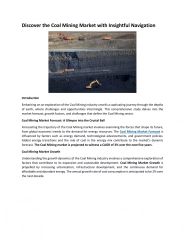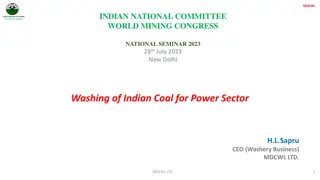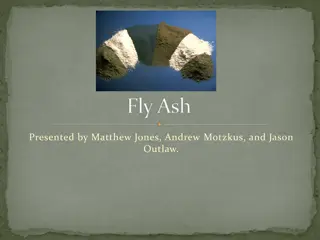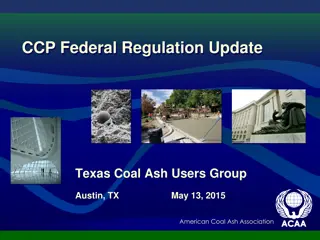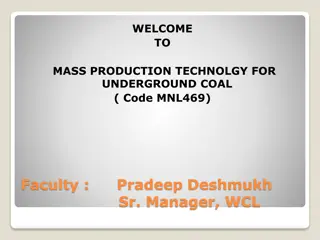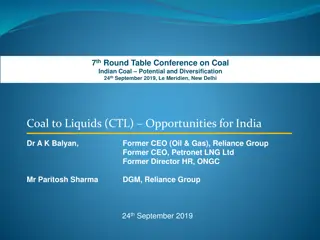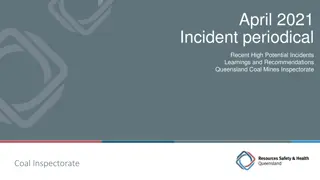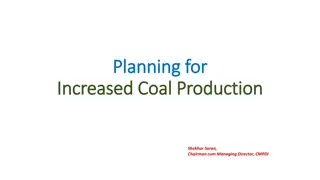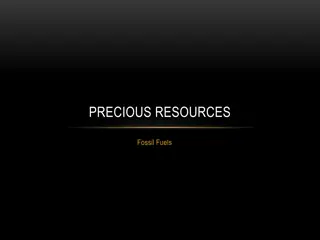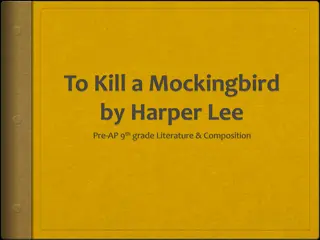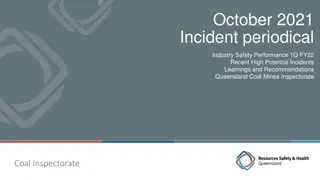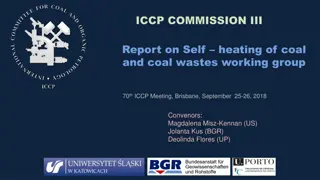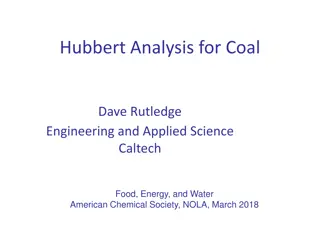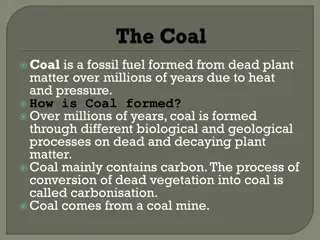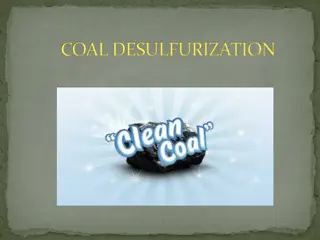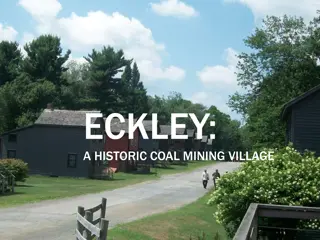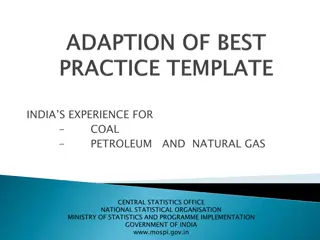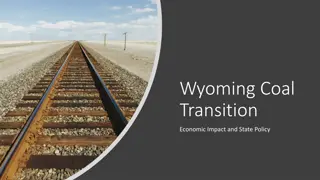Analyzing Laurie Lee's Language in Describing Coal Tips
Laurie Lee's use of language to describe the coal tips is analyzed in this text. Emphasis is placed on identifying descriptions starting from paragraph 6 onwards, highlighting the effectiveness of chosen words and phrases in creating vivid imagery and conveying emotions to the reader.
Download Presentation

Please find below an Image/Link to download the presentation.
The content on the website is provided AS IS for your information and personal use only. It may not be sold, licensed, or shared on other websites without obtaining consent from the author.If you encounter any issues during the download, it is possible that the publisher has removed the file from their server.
You are allowed to download the files provided on this website for personal or commercial use, subject to the condition that they are used lawfully. All files are the property of their respective owners.
The content on the website is provided AS IS for your information and personal use only. It may not be sold, licensed, or shared on other websites without obtaining consent from the author.
E N D
Presentation Transcript
How Practice questions Key points to remember: Highlight what is asked for in question; Comment on what is said and explain how the quote/ language works/ answer the question is the most important element of this response. Systematically work through evidence /effect Integrate technique reference into answer the choice of emotive language here quote .. Persuades .. Consider title/ tone/ language choices/ images/ presentational devices and structure in the text and respond to these ideas in your answer. (consider the whole text) Time and marks: * 5 marks = 7-8 minutes reading and answering the question; * 10 marks = 15 minutes reading and answering the question; Use terms such as: the writer/ author and the reader
When we ask how effects have been created we want to know why certain words have been chosen and how they make the reader think and feel. We want to know what connotations a particular word has. Think about the different connotations of the words coming up. Which is worse? Which is kinder? Which would make a situation more urgent or more severe? Can you add them to your book and annotate the different nuances in meaning?
Slim vs. Skinny Wrong vs. Incorrect Fat vs. Curvy Killed vs. Slaughtered Stolen vs. Taken Average vs. Normal
Stolen vs. Taken The adjective stolen is loaded with a variety of negative connotations. The phrase implies illegal activity and an item being removed without the owner s consent. This makes the person taking the item seem underhand. There is also a need to blame or attribute responsibility. Someone should have to pay for such a crime. If the word taken had been used, a far less dramatic effect would have been created and the reader would not feel quite so incensed; perhaps it was accidental. It is this reaction to crime that the text relies on to seek support from their reader.
Q: How does Laurie Lee use language to describe the coal tips? (10 marks) Highlighter at the ready where can we spot descriptions of the coal tips from paragraph 6 onwards?
Q: How does Laurie Lee use language to describe the coal tips? (10 marks) Highlighter at the ready where can we spot descriptions of the coal tips from paragraph 6 onwards?
Q: How does Laurie Lee use language to describe the coal tips? (10 marks) Highlighter at the ready where can we spot descriptions of the coal tips from paragraph 6 onwards?
Q: How does Laurie Lee use language to describe the coal tips? (10 marks) Highlighter at the ready where can we spot descriptions of the coal tips from paragraph 6 onwards?
Q: How does Laurie Lee use language to describe the coal tips? (10 marks) Can we group the quotes into categories to show how the language is being used? straddling the hillsides mountain of moving muck nudging the houses like blackfurred beasts unthinkable seen danger hit by a wave of stupefying filth as though dumped by the hand of God instantly smothered rising like black pyramids in the western sky more than a hundred inching ominously catastrophe a killer with a rotten heart wanton and indifferent cruelty most treacherous shame both man and God fatal seeping
Q: How does Laurie Lee use language to describe the coal tips? (10 marks) Can we group the quotes into categories to show how the language is being used? How they are moving Threat or menace Violence and consequence
Q: How does Laurie Lee use language to describe the coal tips? (10 marks) Can we group the quotes into categories to show how the language is being used? How they are moving Threat or menace Violence and consequence instantly smothered straddling the hillsides rising like black pyramids in the western sky nudging the houses like blackfurred beasts more than a hundred killer with a rotten heart hit by a wave of stupefying filth inching ominously most treacherous mountain of moving muck fatal seeping
Q: How does Laurie Lee use language to describe the coal tips? (10 marks) Let s look at how the language is used to describe each aspect of the coal tips How they are moving Language is used to describe the coal tips as a gradual but continuous threat slowly moving towards the village. The tips are straddling the hillsides as though they are in charge and dominating the landscape, nudging the houses like blackfurred beasts . This simile suggests a gentle but persistent threat and the noun beasts implies a threat of untamed power and aggression. The tips are slowly inching ominously hinting at the threat and disaster to come. The small village is presented as vulnerable and at the mercy of the contrasting mountain of moving muck which seems to be an unbeatable force. straddling the hillsides nudging the houses like blackfurred beasts inching ominously mountain of moving muck
Q: How does Laurie Lee use language to describe the coal tips? (10 marks) Let s look at how the language is used to describe each aspect of the coal tips. Your turn Threat or menace A sense of threat and menace is presented when the coal tips are described as . rising like black pyramids in the western sky killer with a rotten heart most treacherous fatal seeping
Q: How does Laurie Lee use language to describe the coal tips? (10 marks) Let s look at how the language is used to describe each aspect of the coal tips. Your turn Violence and consequence instantly smothered The slow and gradual language that describes the build-up to the attack is juxtaposed sharply with the attack itself. The gentle threat becomes sudden and has devastating effects when . more than a hundred hit by a wave of stupefying filth
Q: How does Gerardo Arias Camacho convince the reader of the benefits of Fairtrade? (10 marks) Let s look at two answers from an exam. Which is better? What marks would you give each?
Q: How does Gerardo Arias Camacho convince the reader of the benefits of Fairtrade? (10 marks) Let s look at two answers from an exam. Which is better? What marks would you give each? Candidate 1 Candidate 1 Gerardo Arias Camacho convinces the reader of the benefits of Fairtrade by using facts this is shown when it says in the 1980s, the price of coffee was so low that it didn t cover the cost of production this convinces the reader because they can see/read proof and they have something to react on. Gerardo Arias Camacho convinces the reader by using statistics shown when he says we plant trees and have reduced the use of pesticides by 80% in 10 years this makes the reader think about helping and doing something good. Gerardo Arias Camacho convinces the reader by using a colon (:) this is shown when he says Fairtrade is the way trade should be: fair, responsible and sustainable this makes the reader believe Fairtrade is good and makes them willing to act for Fairtrade. Mark out of 10? .. Mark out of 10? ..
Candidate 2 Candidate 2 Camacho convinces the reader that Fairtrade is beneficial by giving us a personal account of his own experiences, using anecdotal language to tell 'the story of a coffee farmer . As a consequence, the reader is convinced that Fairtrade is beneficial as Camacho gives evidence of its positive impact on his family and his community s lives. At the beginning, he refers to the price of coffee in the 1980s to contrast the difficult times then with the times now, where Fairtrade has transformed their lives. He says he was forced to return to America to make the reader feel empathy towards him, with the verb showing how he had no control over his life and that it wasn t his choice. Consequently, Camacho portrays how hard life was when coffee prices were still so low and many farmers abandoned their land and some even left the country, convincing the reader how beneficial it has been because he then goes on to convincing the reader that Fairtrade also has positive impacts on our environment as well as our people. Camacho tells us it s a win-win business and that it s open to everyone to show that Fairtrade can benefit us all. Consequently, he comes to the conclusion that Fairtrade does make a difference because it allows people to help each other . By telling us directly using the word you Camacho convinces us the reader that it is worth us investing in Fairtrade because the benefits are for everyone. He concludes by using the word I repetitively to highlight the positive impact on his life making him feel competitive and has a future . He tells us we can help more people like him by simply going shopping convincing us that Fairtrade is beneficial. Mark out of 10? .. Mark out of 10? ..
Candidate 1 Candidate 1 Gerardo Arias Camacho convinces the reader of the benefits of Fairtrade by using facts this is shown when it says in the 1980s, the price of coffee was so low that it didn t cover the cost of production this convinces the reader because they can see/read proof and they have something to react on. Gerardo Arias Camacho convinces the reader by using statistics shown when he says we plant trees and have reduced the use of pesticides by 80% in 10 years this makes the reader think about helping and doing something good. Gerardo Arias Camacho convinces the reader by using a colon (:) this is shown when he says Fairtrade is the way trade should be: fair, responsible and sustainable this makes the reader believe Fairtrade is good and makes them willing to act for Fairtrade. 1 mark Candidate 2 Candidate 2 Camacho convinces the reader that Fairtrade is beneficial by giving us a personal account of his own experiences, using anecdotal language to tell 'the story of a coffee farmer . As a consequence, the reader is convinced that Fairtrade is beneficial as Camacho gives evidence of its positive impact on his family and his community s lives. At the beginning, he refers to the price of coffee in the 1980s to contrast the difficult times then with the times now, where Fairtrade has transformed their lives. He says he was forced to return to America to make the reader feel empathy towards him, with the verb showing how he had no control over his life and that it wasn t his choice. Consequently, Camacho portrays how hard life was when coffee prices were still so low and many farmers abandoned their land and some even left the country, convincing the reader how beneficial it has been because he then goes on to convincing the reader that Fairtrade also has positive impacts on our environment as well as our people. Camacho tells us it s a win-win business and that it s open to everyone to show that Fairtrade can benefit us all. Consequently, he comes to the conclusion that Fairtrade does make a difference because it allows people to help each other . By telling us directly using the word you Camacho convinces us the reader that it is worth us investing in Fairtrade because the benefits are for everyone. He concludes by using the word I repetitively to highlight the positive impact on his life making him feel competitive and has a future . He tells us we can help more people like him by simply going shopping convincing us that Fairtrade is beneficial. 10 marks
Q: How does the writer try to show that Agbo is not a good place to live? (10 marks) Can you highlight the relevant quotes and respond to the question independently?
Q: How does the writer try to show that Agbo is not a good place to live? (10 marks) Did you perhaps find ? vast dumping site bleak landscape chaotic in places desolate, rubbish- strewn sprawling site dump young people scavenge died from cancers death rate for babies is high here trawl the site foul-smelling smoke head-pounding inhaling the poisonous fumes midst of its filth and fumes
Need a hand getting started? Look at the language used to describe the rubbish site. How is it made to sound as though all hope has gone? Is there anything redeeming? How is it made to sound overwhelming and never-ending? Overpowering? How are the behaviours and actions of the young people described? How is their youth juxtaposed with the dreadful illnesses? Is this a fate we would expect for young people? How are the unpleasant conditions described? How are they made to sound constant? Almost attacking the workers? Is there any escape?
Can you complete the answer below? The writer shows that Agbo is not a good place to live by describing the environment as huge and overpowering. Phrases like vast and sprawling suggest that there is no end to the disgusting site and that it is almost squatting leisurely on the land. Furthermore, Agbo is clearly a dangerous place for people to live and work. A bitter juxtaposition is created between the youth of the workers and their almost inevitable fate. The verbs scavenge and trawl suggests a sense of urgency, desperation and almost hopelessness. The repeated references to illness and death emphasises .. Also, the writer carefully depicts the rubbish site as a constant and pervasive threat
Q: How does John Humphrys persuade the reader he hates noise? (10 marks) Highlighter at the ready can we spot language or techniques to show his hatred of noise?
Q: How does John Humphrys persuade the reader he hates noise? (10 marks) Highlighter at the ready can we spot language or techniques to show his hatred of noise?
Q: How does John Humphrys persuade the reader he hates noise? (10 marks) Highlighter at the ready can we spot language or techniques to show his hatred of noise?
Q: How does John Humphrys persuade the reader he hates noise? (10 marks) Highlighter at the ready can we spot language or techniques to show his hatred of noise?
Q: How does John Humphrys persuade the reader he hates noise? (10 marks) Need a hand getting started? Look to the highlighted sections. Can you comment on .? - The effect of questions and answers on the reader, with the humorous asides about how early he goes to bed? - The contrasting similes used to describe his sleep - The hyperbole and humour used to describe people who talk at 9pm as selfish souls - The aside to the reader that flatters and compliments - The witty alliteration suggesting carols are mass produced and dreadful - The hyperbole with the leaf blower - The brackets used for humour (silent)
Q: How does the writer use language to describe the storm? marks) (10 Highlighters at the ready where can we spot descriptions of the storm? Text A Text A is an extract from The Death Zone by Matt Dickinson At speeds touching 80 to 100 kilometres an hour, the storm whipped into the camp just minutes later, plunging the temperature down by ten to fifteen degrees in as many seconds, ripping into the tents in a blinding fury of driving snow. The storm swept up the southern flanks of Everest engulfing the ice-clad slopes effortlessly in a swirling mantle of hurricane-force winds. Within minutes it had the northern side in its grip and then it rose to take the summit. The mightiest mountain in the world disappeared from view as the storm took control. If Shiva, the Hindu god of destruction, and Nemesis, the Greek goddess of retribution, had joined forces they could not have done a better job of devastation than nature itself did on that day. The timing was uncanny, as bad as it was possible to be. If the storm had struck in winter then no one would have been hurt. But as chance would have it, the tempest arrived on the busiest day of the Everest calendar, right in the middle of the pre-monsoon climbing season.
Q: How does the writer use language to describe the storm? marks) (10 Highlighters at the ready where can we spot descriptions of the storm? Text A Text A is an extract from The Death Zone by Matt Dickinson At speeds touching 80 to 100 kilometres an hour, the storm whipped into the camp just minutes later, plunging the temperature down by ten to fifteen degrees in as many seconds, ripping into the tents in a blinding fury of driving snow. The storm swept up the southern flanks of Everest engulfing the ice-clad slopes effortlessly in a swirling mantle of hurricane-force winds. Within minutes it had the northern side in its grip and then it rose to take the summit. The mightiest mountain in the world disappeared from view as the storm took control. If Shiva, the Hindu god of destruction, and Nemesis, the Greek goddess of retribution, had joined forces they could not have done a better job of devastation than nature itself did on that day. The timing was uncanny, as bad as it was possible to be. If the storm had struck in winter then no one would have been hurt. But as chance would have it, the tempest arrived on the busiest day of the Everest calendar, right in the middle of the pre-monsoon climbing season.
Q: How does the writer use language to describe the storm? marks) (10 Perhaps you could structure your answer looking at whipped plunging ripping swirling Verbs to emphasise pace, aggression, dominance Sibilance for speed and hostility, military semantic field aggression, easily defeated mountain. storm swept up the southern flanks engulfing in its grip rose to take the summit storm took control Personification storm as a monster, grip = violence, claws, strength. Clear dominance, no chance of defeat.
Q: How does the writer use language to describe the seaside resort of Broadstairs? Can you highlight the relevant quotes and respond to the question independently? (10 marks)
Q: How does the writer use language to describe the seaside resort of Broadstairs? (10 marks) Did you perhaps find ? Personification posing for picture place seems to respond almost as if the destination wants to be painted in its best light. Slow and calm ripple plays world of butterflies hovering ocean lies winking Messy and tired in the heat like the dog like faint fish strewn about tangled confused Messy simile but warm as if a family of giants had been making tea here for an age . fantasy, warm image of family holiday, having tea and scattering tea leaves. Juxtaposition of memory nostalgia honour pretty little gay place .now bleak dimly traditional
Q: How does Angela Epstein try to show that life is not easy for a working mother ? (10 marks) Can you highlight the relevant quotes and respond to the question independently?
Q: How does Angela Epstein try to show that life is not easy for a working mother ? (10 marks) Did you perhaps find ? crisis hour tired hungry children collide with irritable parents edge the household towards complete and utter meltdown I thundered ordered She cranked up her howling In desperation uttered the magic words Every day is a demented juggle anything for an easy life
Q: How does the writer show that he feels intimidated on his journey? (10 marks) Can you highlight the relevant quotes and respond to the question independently?
Q: How does the writer show that he feels intimidated on his journey? (10 marks) Did you perhaps find ? lake was rough very rough little boat tossed about tiny in my little vessel endless advancing walls of enemy waves battered the front of the boat chucked about like a piece of driftwood steep sides of the valley that towered high up above the dark water landscape looked rather nightmarish stark grey rocks littered with the burnt skeletons of dead trees cliffs loomed over me like predatory giants
Q: How does the writer create an uncomfortable and unpleasant atmosphere? Can you highlight the relevant quotes and respond to the question independently? (10 marks)
Q: How does the writer create an uncomfortable and unpleasant atmosphere? (10 marks) Did you perhaps find ? dragged stabs his fork slaps it on my plate hot wave of hate goes through me chucks it across the lawn prise from its aluminium coffin pretty pink ham, evil jelly a scientist exhuming a mummified corpse wouldn t have been as patient as I am perhaps it is the way I am doing it, like someone has put poo on my plate silently fuming if he were a cartoon you d see the smoke coming out of his ears


